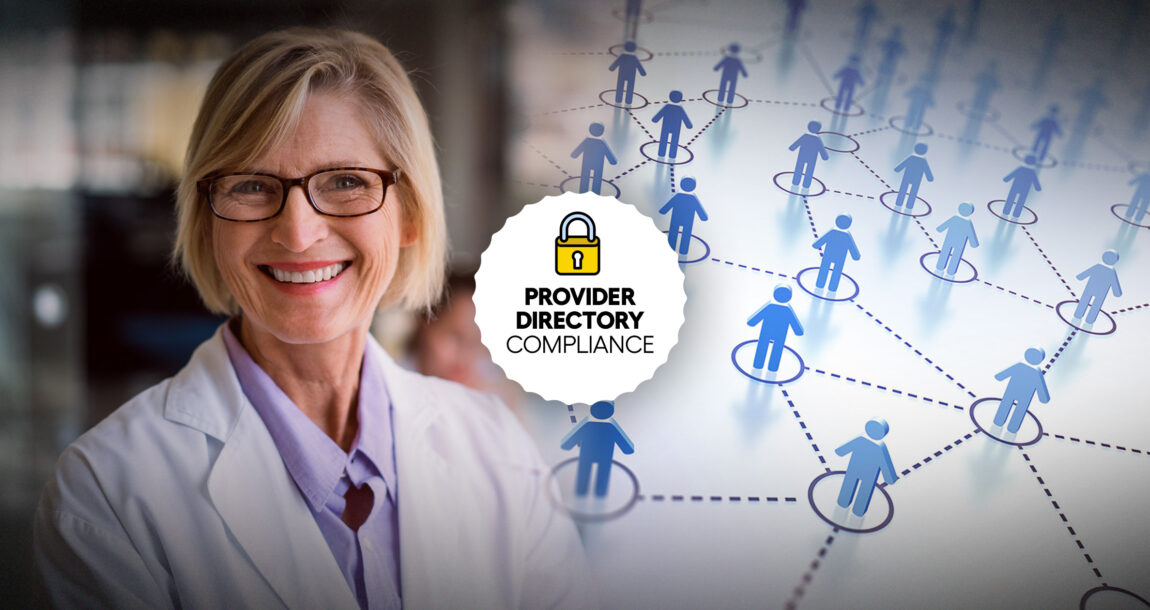Ensuring compliance for PDF provider directories

Current laws such as the Americans with Disabilities Act, the Affordable Care Act, and Section 508 of the Rehabilitation Act, as well as many state laws, mandate that customer communications for health care companies be accessible for people with disabilities. Online communications, including PDF documents, must function with assistive technology such as screen readers or connected Braille displays, which people with disabilities use to access digital information.
Challenges of PDFs

PDFs are tricky documents. Although they have many benefits such as security and the ability to be used on diverse devices with various applications, they pose challenges for digital accessibility. What a sighted person sees in a PDF is not always what a person using assistive technology gets. To make documents accessible, digital tags are added to each document element, allowing assistive technology to relay information on the page and navigate it easily.
For example, when documents are created, sometimes the digital reading order isn’t the same as what a sighted person sees. A provider entry may be added to a page after completing most of the page. To a sighted person, this would look fine. But the digital reading order might place the inserted provider listing as last on the page, instead of under the correct heading. This could prevent assistive technology users from seeing all the providers in their area. So it is necessary to ensure each element on the page is digitally tagged in the correct sequence.
A recent audit of more than 70 publicly available PDF provider directories found most are inaccessible to people with disabilities and not legally compliant. More than 50% of provider directories examined had no tags for accessibility, and even those with tags contained errors rendering the document unusable for an assistive technology user.
Remediating PDF provider directories
Insurance companies compile numerous physician or provider directories across multiple plans and regions, with many provided in multiple languages. The sheer volume and complexity of these directories, often spanning thousands of pages, pose a formidable challenge in remediating them to meet accessibility standards. Most organizations fall short of compliance because they do not have the resources to make the PDFs accessible, or they outsource to manual remediators, who are prone to human error.
Common PDF accessibility errors
The most common errors in provider directories are flawed heading structure, incorrect reading order, and lack of alternative text (alt-text) on images. Automated checkers often fail to detect these issues, meaning manual verification with assistive technologies like screen readers is necessary.
· Heading structure
Headings make a document navigable so the user can find specific content by tabbing through the headings.
Why it matters
A lack of proper heading structure can make it difficult or impossible for users to locate specific information, such as differentiating dermatologists or cardiologists among thousands of other physicians. It could take hours to tab through the content of a 1,500-page directory to find the correct entry.
· Reading order
Another common issue among tagged documents is reading order. In tagged documents, visual appearance may not accurately reflect the digital reading order. This often isn’t observable to a sighted person, only someone using assistive technology.
Why it matters
Most physician directories are arranged in a multicolumn format. Without the correct reading order, someone using assistive technology might get content from line one of EACH column reading from left to right across the page, rather than reading down each column. That will not provide accurate information to help a patient find the right doctor and can break up content that belongs together.
· Image alt-text
Many directories we audited contained untagged images.
Why it matters
When images are untagged, rather than explaining what the image portrays, the assistive technology announces “IMAGE” without providing context. This is particularly problematic when directories contain icons conveying crucial information like proximity to public transportation or the availability of accessible restrooms.
Achieving accessibility at scale
Maintaining accessible provider directories can be daunting due to the size and complexity of these enormous documents, especially when they are updated regularly. There are a number of solutions available that can help. In all cases, it is necessary to validate the accessibility of the final remediated PDFs. Automated testing alone cannot determine whether remediated documents are accessible. A passing accessibility report doesn’t always mean the documents are accessible. Manual checks for heading structure, reading order, alt text, and overall usability are necessary.
Outsourcing
One common option is outsourcing to a remediation company. These teams of remediators will manually tag your PDFs and send them back. Audits have shown that many documents sent for manual outside remediation were returned riddled with accessibility errors, so it is necessary to check the results for errors due to shortcuts and human error.
In-house remediation
Another option is to remediate in-house. There are software solutions that can make this easier, saving time and removing many of the manual remediation tasks, particularly those involved with reading order, lists and tables. An in-house solution is best suited for an organization with a dedicated accessibility team possessing both the skills and the time to accurately remediate documents.
Automation
A newer option is choosing an automated solution, which can vary widely in quality. Some out-of-the-box options add some digital tags but can’t correctly add tags like alt text or the correct level of each heading.
There are also solutions based on artificial intelligence that can be trained on a specific series of documents. These are AI-powered, machine learning models that automatically tag the PDFs correctly after being trained on sample documents. They can be incredibly fast and accurate because once trained to correctly identify PDF elements, they apply the tags quickly and precisely, every time.
Not all automated tools are created equally, so thoroughly check the results before relying on these solutions.
Choosing a solution
With digital accessibility laws becoming increasingly strict and enforcement on the rise, it's vital to choose a solution that ensures long-term compliance for your organization.
Consider the following questions when choosing a PDF remediation solution:
- How many provider directories and how many pages does each PDF contain?
- What is your timeline?
- What is your remediation budget?
- How many staff members are experienced in PDF accessibility and will be assigned to the project? Who will oversee the work?
- How will the completed documents be validated for accessibility?
Making directories accessible and compliant
Navigating the complexities of remediating large, complex PDF physician directories is essential for legal compliance and enhanced user experience. Select a solution tailored to your documents, team, budget, and timeline. Prioritize validation to ensure the directories are fully usable to safeguard your organization's reputation and user satisfaction.
Tammy Albee is director of marketing, Equidox Software Co. Contact her at [email protected].
© Entire contents copyright 2024 by InsuranceNewsNet.com Inc. All rights reserved. No part of this article may be reprinted without the expressed written consent from InsuranceNewsNet.com.






Trade group files first lawsuit against the DOL fiduciary rule
Inflation is still the top financial challenge for many Americans
Advisor News
- Mitigating recession-based client anxiety
- Terri Kallsen begins board chair role at CFP Board
- Advisors underestimate demand for steady, guaranteed income, survey shows
- D.C. Digest: 'One Big Beautiful Bill' rebranded 'Working Families Tax Cut'
- OBBBA and New Year’s resolutions
More Advisor NewsAnnuity News
- MetLife Declares First Quarter 2026 Common Stock Dividend
- Using annuities as a legacy tool: The ROP feature
- Jackson Financial Inc. and TPG Inc. Announce Long-Term Strategic Partnership
- An Application for the Trademark “EMPOWER PERSONAL WEALTH” Has Been Filed by Great-West Life & Annuity Insurance Company: Great-West Life & Annuity Insurance Company
- Talcott Financial Group Launches Three New Fixed Annuity Products to Meet Growing Retail Demand for Secure Retirement Income
More Annuity NewsLife Insurance News
Property and Casualty News
- Best’s Special Report: Lower U.S. Property/Casualty Insurer Expenses Boost Segment’s Underwriting Results
- AIG CEO Peter Zaffino to step aside by mid-2026; succession plan revealed
- Alinsco Insurance Completes Zero-Downtime VMware Exit with VergeOS
- The Hartford Expands Technology Team With New Office In Columbus, Ohio
- American Integrity Insurance Group Expands into North Carolina, Reflecting its Ongoing Regional Growth Strategy
More Property and Casualty News